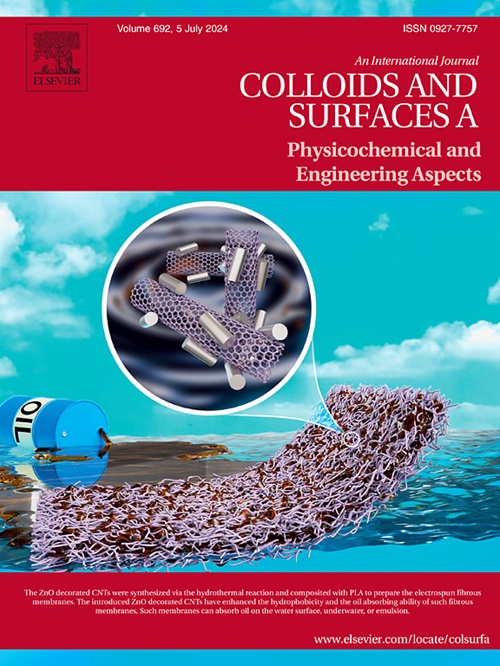Evaporation dynamics and deposition patterns of ethanol-based Al2O3 nanofluid droplets: Effects of particle sizes and substrate temperatures
IF 4.9
2区 化学
Q2 CHEMISTRY, PHYSICAL
Colloids and Surfaces A: Physicochemical and Engineering Aspects
Pub Date : 2025-04-27
DOI:10.1016/j.colsurfa.2025.137040
引用次数: 0
Abstract
The evaporation of nanofluid droplets holds significant potential for applications in thermal management. Nonetheless, the ways in which nanoparticles affect the evaporation dynamics and deposition properties of nanofluid droplets are still not well understood. Here, we investigate the effects of Al₂O₃ nanoparticle sizes and substrate temperatures on the wetting characteristics, evaporation rate, and particle deposition behavior of ethanol-Al₂O₃ nanofluid droplets. Additionally, the features and transitions of internal convective instabilities are observed and discussed. The results reveal that the addition of nanoparticles has a minor impact on the changes in wetting patterns during droplet evaporation, and all droplets evaporate in a mixed mode. Nanoparticle size plays a pivotal role in regulating deposition patterns and wetted area, which in turn indirectly affects the evaporation rate. Specifically, the heat flux at the solid-liquid interface and the evaporation rate are enhanced compared to the base fluid, with these differences becoming more pronounced at higher substrate temperatures and with larger nanoparticle sizes. The internal convection within the droplets is primarily driven by Marangoni flow, and the presence of nanoparticles has negligible influence on the flow behavior. Smaller nanoparticles tend to deposit near the center of the droplet, resulting in a reduced coffee-ring effect, whereas larger nanoparticles predominantly deposit at the contact line, forming a marked coffee ring. Therefore, by selecting nanoparticles of appropriate sizes, it is possible to enhance evaporation rates or mitigate the coffee-ring effect to meet the requirements of various industrial applications.
乙醇基Al2O3纳米液滴的蒸发动力学和沉积模式:粒径和衬底温度的影响
纳米流体液滴的蒸发在热管理方面具有巨大的应用潜力。然而,纳米颗粒影响纳米流体液滴蒸发动力学和沉积特性的方式仍未得到很好的理解。在这里,我们研究了Al₂O₃纳米颗粒尺寸和衬底温度对乙醇-Al₂O₃纳米流体液滴的润湿特性、蒸发速率和颗粒沉积行为的影响。此外,还观察和讨论了内部对流不稳定性的特征和转变。结果表明,纳米颗粒的加入对液滴蒸发过程中润湿模式的变化影响较小,所有液滴都以混合模式蒸发。纳米颗粒的大小在调节沉积模式和湿润面积方面起着关键作用,从而间接影响蒸发速率。具体来说,与基液相比,固液界面的热流密度和蒸发速率都得到了增强,在基材温度较高和纳米颗粒尺寸较大时,这些差异变得更加明显。液滴内部对流主要由马兰戈尼流驱动,纳米颗粒的存在对流动行为的影响可以忽略不计。较小的纳米颗粒倾向于沉积在液滴中心附近,导致咖啡环效应减弱,而较大的纳米颗粒主要沉积在接触线上,形成一个明显的咖啡环。因此,通过选择适当尺寸的纳米颗粒,可以提高蒸发速率或减轻咖啡环效应,以满足各种工业应用的要求。
本文章由计算机程序翻译,如有差异,请以英文原文为准。
求助全文
约1分钟内获得全文
求助全文
来源期刊
CiteScore
8.70
自引率
9.60%
发文量
2421
审稿时长
56 days
期刊介绍:
Colloids and Surfaces A: Physicochemical and Engineering Aspects is an international journal devoted to the science underlying applications of colloids and interfacial phenomena.
The journal aims at publishing high quality research papers featuring new materials or new insights into the role of colloid and interface science in (for example) food, energy, minerals processing, pharmaceuticals or the environment.

 求助内容:
求助内容: 应助结果提醒方式:
应助结果提醒方式:


